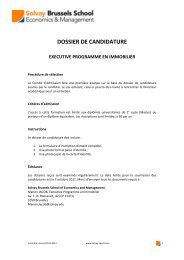behavioural finance and portfolio management - Solvay Brussels ...
behavioural finance and portfolio management - Solvay Brussels ...
behavioural finance and portfolio management - Solvay Brussels ...
Create successful ePaper yourself
Turn your PDF publications into a flip-book with our unique Google optimized e-Paper software.
B E H A V I O U R A L F I N A N C E A N D<br />
P O R T F O L I O M A N A G E M E N T<br />
Bertr<strong>and</strong> SLUYS<br />
COURSE SUMMARY<br />
Learning Outcomes<br />
This course is intended to provide professionals <strong>and</strong> individuals interested in market<br />
<strong>finance</strong> with strong fundamentals in <strong>behavioural</strong> <strong>finance</strong>, <strong>portfolio</strong> <strong>management</strong> <strong>and</strong><br />
investment strategies.<br />
The key idea is to bring behavioral <strong>finance</strong> concepts down to earth in a concise way to<br />
improve the investment or trading skills of the student.<br />
This covers the analysis of the necessary conditions of different markets pattern (bear, bull,<br />
trading range) development of simple market timing in excel <strong>and</strong> the development of plain<br />
vanilla options strategies on equity indices.<br />
The ultimate objective of the course is to give the students all the tools to establish his own<br />
investment or trading plan.<br />
After this course, you will be able to:<br />
<br />
<br />
<br />
<br />
<br />
<br />
be free of behavioral disorders when you take an investment decision<br />
manage a <strong>portfolio</strong> by achieving absolute positive return even in situation of<br />
crisis<br />
build an living investment or trading process<br />
master options <strong>and</strong> futures strategy on equity indices<br />
build simple model in Excel<br />
have a solid underst<strong>and</strong>ing of the notion of risk : probability, permanent loss,<br />
black swan<br />
1
Audience<br />
This course is intended to professionals <strong>and</strong> individuals with a strong desire to improve<br />
their investments decision.<br />
Lecturer: Bertr<strong>and</strong> SLUYS<br />
Bertr<strong>and</strong> SLUYS is a senior <strong>portfolio</strong> manager specialized in alternative<br />
strategies. He is working with Fuchs <strong>and</strong> associés Finance to offer client the<br />
Vega Delta Investment program developed by himself for the last 15 years. A<br />
hedge fund based on his strategies is also under construction. Bertr<strong>and</strong> gives<br />
also classes at Vlerick school of Management at EFFAS <strong>and</strong> Febelfin<br />
programs.<br />
He is also the founder of the Association of individual investors.<br />
Reference<br />
Main<br />
<br />
Sharpe, Alex<strong>and</strong>er <strong>and</strong> Bailey, Investments (1998), sixth edition, ISBN-10:<br />
0130101303<br />
Other very pedagogical references:<br />
Michael C. Thomsett (February 27 2008), Winning with Options: The Smart Way to<br />
Manage Portfolio Risk <strong>and</strong> Maximize Profit, AMACOM.<br />
Jeremy Siegel (1998), Stocks for the long run. McGraw-Hill.<br />
Alex<strong>and</strong>er Elder (1993), Trading for a living. John Wiley & Sons Inc.<br />
Nassim Nicholas Taleb (2005). Fooled by r<strong>and</strong>omness, R<strong>and</strong>om House Trade.<br />
James Montier (February 2010). The little book of behavioral investing, Little books,<br />
big profits<br />
John Mauldin (May 2004),Bull's Eye Investing: Targeting Real Returns in a Smoke<br />
<strong>and</strong> Mirrors Market<br />
Pre-requisites<br />
The course is supposed to be “self-containing” or “self-explanatory”. But recommending<br />
participants to read at least diagonally some key chapters for the jargon, some key concepts,<br />
or some key technical fundamentals is key, for such dense <strong>and</strong> swift programs.<br />
2
OUTLINE<br />
Day 1 :<br />
Behavioural <strong>finance</strong> <strong>and</strong> lessons learned from history<br />
Behavioural <strong>finance</strong><br />
Introduction to the Course<br />
Main objective: to build a personal investment process<br />
Investment versus speculation<br />
Behavioural <strong>finance</strong>: key points<br />
The anatomy of a bubble<br />
Performance evaluation: a quantitative <strong>and</strong> qualitative approach<br />
Portfolio performance evaluation <strong>and</strong> return attribution<br />
Simple <strong>and</strong> Continuous returns<br />
IRR <strong>and</strong> Time-Weighted Return<br />
Risk adjusted performance<br />
Lessons learned from history<br />
Risk: not only st<strong>and</strong>ard deviation<br />
What history tells us?<br />
Asset allocation<br />
o Risk <strong>and</strong> return. What history tells us?<br />
o What to expect for the next 10 year?<br />
o Strategic, tactical, dynamic<br />
Market timing: is it working?<br />
o Indicators building: short, medium <strong>and</strong> long term<br />
o Implementation: futures <strong>and</strong> options (an introduction)<br />
Case(s): Vega Delta Investment program performance<br />
Futures <strong>and</strong> options key points<br />
3
Day 2 :<br />
Market timing models, options strategies, Kelly criteria<br />
Building <strong>and</strong> using a Market timing indicators<br />
Options strategies<br />
o Pay off at expiration of long short call put<br />
o Design of a Black <strong>and</strong> schools models in excel<br />
o Greeks <strong>and</strong> excel simulation<br />
o Put call parity<br />
o Key strategies<br />
o Option strategies adapted to different market condition<br />
o Directional <strong>and</strong> not directional<br />
Putting it all together: probability, black swan, <strong>behavioural</strong> <strong>finance</strong> <strong>and</strong><br />
option strategies<br />
o How to avoid a “permanent” loss<br />
o The notion of risk budgeting<br />
o VIX <strong>and</strong> the choice of strategy<br />
o Market timing models <strong>and</strong> probability<br />
Case(s): Example of options strategies adapted to current<br />
market conditions<br />
o Building of positions<br />
o Management of positions<br />
4
















